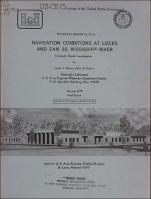Please use this identifier to cite or link to this item:
https://hdl.handle.net/11681/13632| Title: | Navigation conditions at Locks and Dam 26, Mississippi River : hydraulic model investigation |
| Authors: | United States. Army. Corps of Engineers. St. Louis District Shows, Louis J. Franco, John J. |
| Keywords: | Fixed-bed models Mississippi River Hydraulic models Navigation conditions Lock and Dam No. 26, Mississippi River Locks Waterways Hydraulic structures Inland navigation |
| Publisher: | Hydraulics Laboratory (U.S.) Engineer Research and Development Center (U.S.) |
| Series/Report no.: | Technical report (U.S. Army Engineer Waterways Experiment Station) ; HL-79-19. |
| Description: | Technical Report Abstract: Locks and Dam 26 Replacement is proposed for construction on the Mississippi River about 2 miles downstream of the existing locks and dam at Alton, Illinois, as part of the program for the modernization of navigation facilities on the river. The project would replace the smaller existing structure with a large, modern structure designed to handle two-way traffic. The proposed structure would include two parallel locks separated by two 110-ft gate bays along the left bank and a dam consisting of a gated spillway and fixed overflow section. A fixed-bed model reproduced about 6.7 miles of the Mississippi River Channel, Ellis and Maple Islands, and the adjacent overbank areas to an undistorted scale of 1:120. The model study was concerned with the composition and configuration of the dam, arrangement and separation of the locks and lock walls, and navigation conditions in the lock approaches. The investigation has produced the following general results and conclusions: (A.) Satisfactory navigation conditions for two-way traffic could be developed at either the existing site or the proposed replacement site by providing gates between the locks. The number of gates in the proposed gated spillway could be reduced to seven without producing any significant changes affecting the movement of a tow approaching the locks. (B.) Currents in the upper approach to the landward lock at the alternate site would be affected by the eddy forming along the left overbank. Placing a fill along the overbank to an elevation above normal pool would reduce the effect of the eddy on navigation. (C.) Ports will be required in the upper guard walls to reduce the intensity of the crosscurrent near the end of the walls. The riverward lock guard wall should extend farther upstream than the landward guard wall. (D.) In the lower lock approaches, navigation conditions for two-way traffic could be improved with guard walls shorter than 1200 ft. (E.) With the locks separated, navigation conditions could be developed in both the upstream and downstream approaches with the locks used simultaneously without the operation of one interfering with the operation of the other. (F.) During construction of the project, adequate navigation conditions could be maintained by using a three- stage cofferdam with the first stage located on the Missouri side and the third stage along the Illinois side. (G.) Scouring of the bed can be expected along the upper corners of the cofferdams on the river side, particularly during long periods of extreme flow conditions. Along the main cofferdam, scouring can be eliminated or minimized with a deflector installed at the upstream corner on the river side of each cofferdam. NOTE: This file is large. Allow your browser several minutes to download the file. |
| Rights: | Approved for public release; distribution is unlimited. |
| URI: | http://hdl.handle.net/11681/13632 |
| Appears in Collections: | Technical Report |
Files in This Item:
| File | Description | Size | Format | |
|---|---|---|---|---|
| TR-HL-79-19.pdf | 13.62 MB | Adobe PDF |  View/Open |